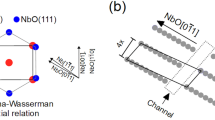Abstract
The work is devoted to the X-ray diffraction research of defected niobium oxide nonuniform (NON) arrays and niobium oxide nanocolumns formed by electrochemical anodizing. The obtained results allow to make an assumption about the probable presence of a significant amount of NbO, NbO0.7, Nb2O5 and a small amount of NbO2, and Al in the composition of defected NON and the presence of all these substances in the nanocolumns of niobium oxide except NbO0.7, but in smaller quantities. The comparative analysis of the NON structure and the nanocolumns makes it possible to isolate, probably, a significant amount of Nb0.94O0.06, Nb6O in the defected nanocolumns, which was not found in NON.



Similar content being viewed by others
REFERENCES
V. Surganov and G. Gorokh, Symp. on Design,Test, Integration, and Packaging of MEMS/MOEM, Vol. 4019 (2000). https://doi.org/10.1117/12.382321
A. Mozalev, R. M. Vázquez, C. Bittencourt, D. Cossement, F. Gispert-Guirado, E. Liobel, and H. Habazaki, J. Mater. Chem. C 2 (24), 4847 (2014). https://doi.org/10.1039/c4tc00349g
A. Pligovka, A. Lazavenka, and A. Zakhlebayeva, Proc. 18th Int. Conf. Nanotechnology (IEEE-NANO) (Cork, Ireland, 2018). https://doi.org/10.1109/NANO.2018.8626387
A. Pligovka, A. Zakhlebayeva, and A. Lazavenka, J. Phys.: Conf. Ser. 987 (1), 012006 (2018). https://doi.org/10.1088/1742-6596/987/1/012006
A. N. Pligovka and G. G. Gorokh, Nanostructures in Condensed Media: Collection of Scientific Articles (ITMO im. A. V. Lykova, Minsk, 2014), pp. 310–319 [in Russian].
A. Pligovka, A. Lazavenka, and G. Gorokh, IEEE Trans. Nanotechnol. 18 (125), 790 (2019). https://doi.org/10.1109/TNANO.2019.2930901
A. Mozalev, A. J. Smith, S. Borodin, A. Plihauka, A. W. Hassel, M. Sakairi, and H. Takahashi, Electrochim. Acta 54 (3), 935 (2009). https://doi.org/10.1016/j.electacta.2008.08.030
A. Mozalev, M. Bendova, F. Gispert-Guirado, and E. Llobet, Chem. Mater. 30 (8), 2694 (2018). https://doi.org/10.1021/acs.chemmater.8b00188
A. Mozalev, V. Khatko, C. Bittencourt, A. W. Hassel, G. Gorokh, E. Liobel, and X. Correig, Chem. Mater. 20 (20), 6482 (2008). https://doi.org/10.1021/cm801481z
G. G. Gorokh, A. N. Pligovka, and A. A. Lozovenko, Tech. Phys. 64 (11), 1657 (2019). https://doi.org/10.1134/S1063784219110124
A. Mozalev, M. Sakairi, I. Saeki, and H. Takahashi, Electrochim. Acta 48 (20), 3155 (2003). https://doi.org/10.1016/S0013-4686(03)00345-1
M. A. Porai-Koshits, Fundamentals of Structural Analysis of Chemical Compounds: Textbook (Vysshaya Shkola, Moscow, 1989) [in Russian].
Ya. S. Umansky and N. V. Chirikov, Physical Encyclopedia (Great Russian Encyclopedia, Moscow, 1994), Vol. 4, pp. 377–378 [in Russian].
V. D. Krylov, Chemical Encyclopedia (Great Russian Encyclopedia, Moscow, 1995), Vol. 4, pp. 242–243 [in Russian].
V. S. Gorshkov, V. V. Timashev, and V. G. Savel’ev, Methods for Physicochemical Analysis of Binding Agents: Textbook (Vysshaya Shkola, Moscow, 1981), p. 335 [in Russian].
I. M. Zharskii and G. I. Novikov, Physical Research Methods in Inorganic Chemistry (Vysshaya Shkola, Moscow, 1988), p. 271 [in Russian].
R. S. Saifullin, Physicochemistry of Inorganic Polymer and Composite Materials (Khimiya, Moscow, 1990), p. 240 [in Russian].
N. M. Bobkova, Physical Chemistry of Refractory Nonmetallic and Silicate Materials (Vysshaya Shkola, Minsk, 2007), p. 301 [in Russian].
A. V. Kolpakov, Physical Encyclopedia (Sov. Encyclopedia, Moscow, 1988), Vol. 1, pp. 671–674 [in Russian].
ACKNOWLEDGMENTS
The authors express their gratitude to the Organizing Committee of the XXIV International Symposium “Nanophysics and Nanoelectronics” for the opportunity to present the research results. The authors thank Ulyana Turovets from the Belarusian State University of Informatics and Radioelectronics (BSUIR) for her help with computer modeling of the scheme of niobium oxide nonuniform arrays formation and Associate Professor of BSUIR, Alexander Poznyak, for valuable discussions.
Funding
The work was supported by the state research program of the Republic of Belarus “Convergence 2020” (task 3.03) and the scientific and technical program of the Union State “Technology-SG” (task 2.3.2.1) using the equipment of the center for collective use “Physics and Technology of Micro- and Nanostructures” at the Institute of Microstructure physics of the Russian Academy of Sciences.
Author information
Authors and Affiliations
Corresponding author
Ethics declarations
The authors state that they have no conflicts of interest.
Rights and permissions
About this article
Cite this article
Pligovka, A., Yunin, P., Hoha, A. et al. Morphology and Structure of Defected Niobium Oxide Nonuniform Arrays Formed by Anodizing Bilayer Al/Nb Systems. Tech. Phys. 65, 1771–1776 (2020). https://doi.org/10.1134/S1063784220110213
Received:
Revised:
Accepted:
Published:
Issue Date:
DOI: https://doi.org/10.1134/S1063784220110213




